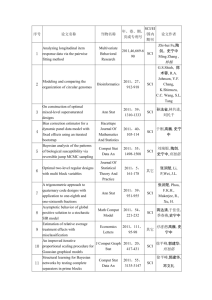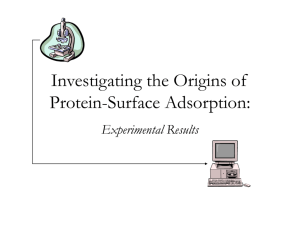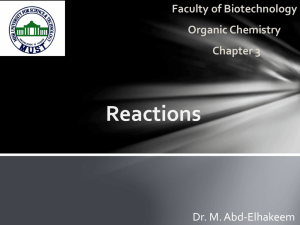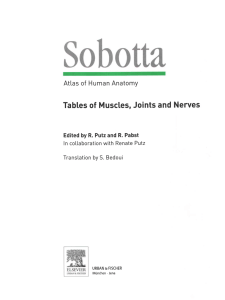Computational modelling for performance improvement of polymer nanocomposites
advertisement
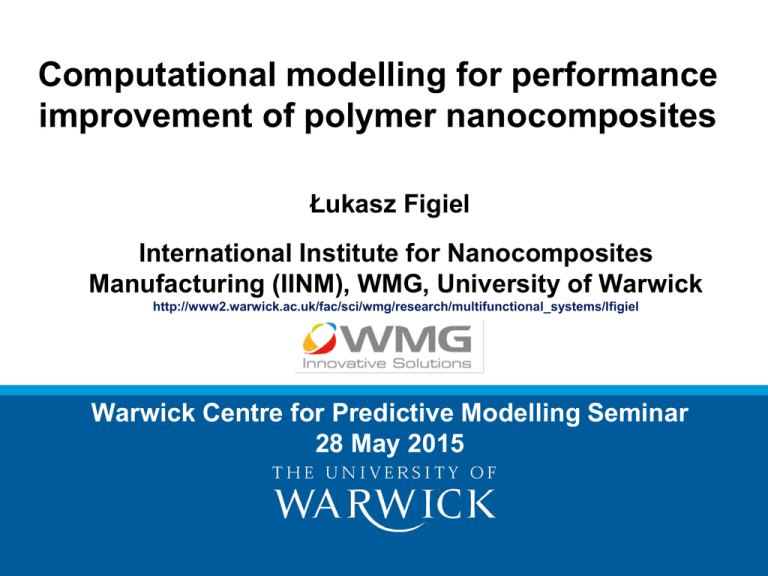
Computational modelling for performance improvement of polymer nanocomposites Łukasz Figiel International Institute for Nanocomposites Manufacturing (IINM), WMG, University of Warwick http://www2.warwick.ac.uk/fac/sci/wmg/research/multifunctional_systems/lfigiel Warwick Centre for Predictive Modelling Seminar 28 May 2015 Ma et al. (2010), 41: 1345, Comp. Part A. IINM Research Understanding Materials at the Nanoscale & Linking with Macroscale Dispersion & distribution; Polymernanoparticle interactions Synthesis, functionalisation, defects Controlled manufacturability at Scale Tracking morphology in primary & secondary processing In-situ characterisation & modelling Delivering Material to the End User IINM Team Prof Tony McNally Director Polymer Science, Processing, Functional Materials Dr Chaoying Wan Polymer Chemistry, Graphene, Biomimetics Dr Claire Dancer Electromagnetic Materials, Ceramics Dr Lukasz Figiel Materials Modelling, Mechanics Dr Vannessa Goodship Polymer Processing Dr Tara Schiller Polymer Characterisation, Biomaterials Modelling Methodology: overview Polymer constitutive law Interface/interphase constitutive law TEM, XRD, AFM RVE Morphology reconstruction: 1 m Homogenisation MACRO Nanofiller properties Localisation Reconstruction of initial morphology 1μm 30 30 25 25 20 20 Count Count ψ ψ ψ Digital reconstruction Experiment TEM/XRD 15 662.731 15 10 10 5 5 0 0.989 3.915 0 2 4 6 8 10 Number of clay platelets 12 14 2 4 6 8 10 12 Number of clay platelets Acceptance-rejection algorithm • Draw samples (e.g. orientation) from a given distribution (e.g. skew-Gaussian) • Intersection/overlap checks • Ensures global/local periodicity • Implementation: Fortran (2D) and Python (3D) 14 Examples of 2D and 3D models 2D models 3D models Constitutive model: polymer matrix Stress-strain behaviour around Tg - entangled polymer Glass-rubber model ‘conformational’ (C) ‘bond-stretching’ (B) Inter/intraatomic potentials ˆ B ˆ C m 1 Total Cauchy stress tensor: Bond-stretching (B) stress tensor: Conformational (C) stress tensor: Stress-induced crystallisation: Entangled network ˆ B ˆ C(i ) ˆ B 2GB Dˆ B where where m K B ln J B B aT , aS , a 1 ˆ (i ) AC 1 3 ˆ ( k ) AC AC = AC ˆ (Ni ) ,T, Ns , , N ˆ (i ) N where ( k ) J N 3 k 1 ˆN ˆ C ˆ C,crit where ˆ C,crit ˆ C,crit aT , as(S) , Dˆ Constitutive model: interface/interphase/gallery 1 i ref aT aS a 2 H aT exp R 1 1 INT T Tref CV C aS exp INT V T f T Tref T Qiao et al. (2011), 49:740, J. Pol. Phys. B (cohesive stress) Clay platelet tan M (t , T INT ref ) EM" (t , TrefINT ) EM' (t , TrefINT ) max f ( ) max (I) (II) Slippage of platelets (III) (slippage) 1 (I): Network stiffness 2 0 (III): Network failure (I) f ( ) 2 1 1 2 if 1 ; (II) f ( ) 1 if 1 2 3 2 2 2 (III) f ( ) 2 3 1 0 2 0 2 if 1 2 , Scale transitions: macro-to-RVE & RVE-to-macro Mechanical field uRVE x macro X u f x macro Fmacro 1 - macro 1 RVE x dVRVE VRVE VRVE Non-mechanical field ref RVE x RVE macromacro x f x qRVE 1 VRVE V RVE qRVE x dVRVE Tangent operator C macro macro macro 1 t x d RVE VRVE RVE N = 1 VRVE f (I ) x( I ) I =1 Case study 1: Secondary processing near Tg After melt extrusion After solid-state forming Morphology evolution 1 m 2 m Experiment Viscous flow Stress-induced crystallisation Simulation Morphology evolution with applied deformation (T=100C) Unstretched TEM image analysis Unstretched =0° Strain ~1.5 Average tactoid orientation [degrees] (Applied) Strain ~1 60 1% 2PLAT 1% 8PLAT 5% 2PLAT 50 40 30 20 10 0 0.5 1 Applied strain 1.5 Strain ~2 Nanocomposite sheet during thermoforming (1000C, 1s-1) Macro model CPE4 L 4 1 1 3 2 2 3 L 5L 4 4 1 5 3 2 Case study 2: Rate-dependent response • CFRP laminates under impact loading Opening of matrix cracks (brittle nature of epoxy) → delamination at the interfaces, structural degradation • Hypothesis: CNT/epoxy surface coating will enhance the impact resistance due to an increase in energy dissipation/absorption. (2) pull-out in form of CNT crack bridging (1) CNT an enhanced nonlinear deformation of the matrix σ22 Force Matrix behaviour MWCNT properties Strain energy function Elastic constants E33zig-zag 31zig-zag 4 3Cr rCNT / 2 9 3 C r 2 r 0 3 C r / C / 22 / 2 Edwards & Vilgis (1986), 27: 483, Polymer 1 Cr r0 / C / 22 r 0 2 2 / C G31zig-zag 2 8 3n sin / 2n Cr 2 2 AC = AC ˆ (Ni ) , T, NC , 2 rCNT / 2 2 6 Cr r02 / C Rejuvenation v Tf Tf 0 (Tf Tf 0 ) 1 exp v 0 Buckley et al. (2004), 52: 2355, J. Mech. Phys. Sol. 14 12cos / n 2cos 2 / n 10 4cos / n 6cos 2 / n Shen and Li (2004) Phys. Rev. B. Adiabatic heating cTf 1 : D b : De T c c Buckley et al. (2004), 52: 2355, J. Mech. Phys. Sol. MWCNTs parameters Values of model parameters Weidt & Figiel (2015), 115: 52, Comp. Sci. Techn. e.g. Cr bond-stretching constant; Cθ bond-angle variation constant; n - chirality Weidt & Figiel (2015), 115: 52, Comp. Sci. Techn. Interface behaviour CNT pull-out via MD Tangential traction-separation law II max F 2.7 MPa E II x II II Fmax S dl Li et al. (2011), 50: 1854, Comp. Mat. Sci . Weidt & Figiel (2015), 115: 52, Comp. Sci. Techn. and Fshear (a) 4 a 12 6 12 6 2 1/3 2 2 1/3 2 6 2 1/3 2 3 a 2 (a 2 ) (a 2 ) Weidt & Figiel (2015), 115: 52, Comp. Sci. Techn. max Di Fshear (a) 0.225nm RVE size: Ensemble size: Weidt & Figiel (2014), 82: 298, Comp. Mat. Sci. Stress-strain rate response, and related parameters Weidt & Figiel (2015), 115: 52, Comp. Sci. Techn. Energy absorption Quasi-static rate (110^-3 s^-1) Impact rate (110^3 s^-1) Weidt & Figiel (2013), In. Njuguna (Ed.), Structural Nanocomposites, 207-224, Springer, 2013. Concluding remarks • Computationally-efficient & accurate, multiscale approach can assist in the optimisation of processing and property enhancements for polymer nanocomposites • Further work ongoing on: – Linking with molecular simulations to account more accurately for nanoparticle functionalization & nanoparticle-polymer interactions – Description of nanoparticle functionalization-related uncertainty – Computational efficiency enhancement for localisationhomogenisation scheme through model reduction and parallel processing – Incorporation of non-mechanical fields (e.g. thermal, electric) into the scheme Acknowledgements • • • • • Dr. C. Pisano, Dr. D. Weidt (University of Limerick, Ireland) Prof. P. Buckley (University of Oxford, UK) Prof. F. Dunne (Imperial College London, UK) Dr. P. Spencer (University of Bradford, UK) Dr. G. Menary (Queen’s University Belfast, UK), Dr. K. Soon, Dr. R. Rajeev (formerly at Queen’s University Belfast, UK) • Prof. A. Galeski (CMMS Lodz, Poland) • • • • • Engineering and Physical Sciences Research Council (EPSRC), UK Materials & Surface Science Institute, University of Limerick, Ireland Irish Research Council (IRC) Irish Centre for High-End Computing (ICHEC) National Science Centre, Poland
